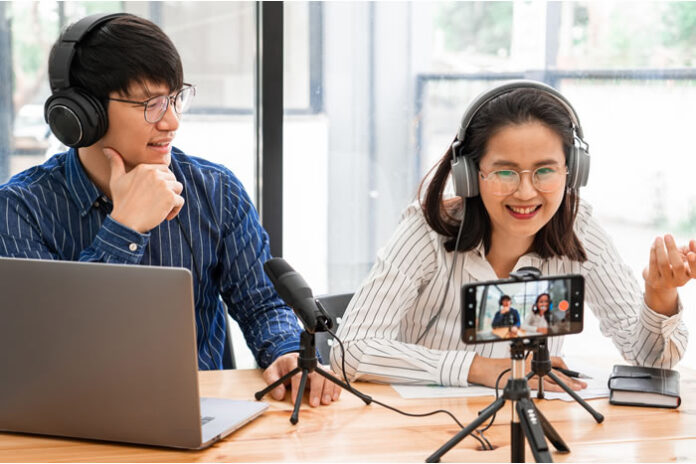A video podcast series is a great way to share information with a wide audience. By creating short episodes that can be easily downloaded and watched on a variety of devices, you can connect individuals all over the world. Whether you’re sharing your expertise on a particular topic or just offering your thoughts on current events, video podcasting is an excellent way to get your voice out there.
In addition, by using video, you can add another level of engagement for your viewers. They can see your expressions and body language, which can help them to better understand your message. So, if you’re looking for a means to connect with a large audience with your message, consider creating a video podcast series. Let’s take a look at some pointers on how to create a successful video podcast series:
1. Choose a catchy name and logo for your video podcast.
A successful podcast depends on two key elements: great content and a strong branding strategy. While the former is certainly more important, the latter can play a big role in helping your podcast stand out from the crowd. An attention-grabbing name and logo are essential for making a good first impression, and they can help to build recognition for your brand over time.
When choosing a name for your podcast, try to be creative and unique. Avoid using common terms or phrases that could be easily confused with other shows. Instead, focus on something that captures the essence of your show. As for the logo, keep it simple and easy to remember. A well-designed logo can be an invaluable asset for promoting your podcast online and offline.
2. Choose topics that will be of interest to your target audience.
When choosing topics for your video podcast, be sure to consider the interests of your target audience. What information or stories would they be eager to hear? What would capture their attention and keep them coming back for more?
Keep in mind that you don’t have to stick to one topic; you can cover a wide range of subjects as long as they are all of interest to your target audience. The key is to choose topics that will appeal to them and give them something to look forward to in each episode. With careful planning, you can create a video podcast that your target audience will love.
3. Decide on the format of your podcast.
There are several things to consider when deciding on the format of your video podcast. The first is the length of each episode. While some podcasts can be hours long, others are only a few minutes. It’s important to find a balance that works for you and your audience.
Second, you’ll need to decide if you want to include interviews or not. Interviews can be an excellent way to add interest and variety to your podcast, but they also take more time to prepare for.
Third, think about the overall structure of your podcast. Are you going to release episodes on a regular schedule, or will they be more sporadic? Will each episode stand-alone, or will they build on each other? Once you’ve answered these questions, you’ll have a better idea of what kind of format will work best for your video podcast.
4. Line up interesting guests for your video podcast episodes.
When planning your video podcast episodes, be sure to line up interesting guests. While you may be tempted to choose guests based on their popularity or notoriety, it’s important to remember that your podcast is about you and your interests. Therefore, you should select guests who will add value to your show and help you attract new listeners.
One place to start is with people you already know. Ask friends, family, and acquaintances if they know anyone who would be a good fit for your podcast. You can also contact local businesses and organizations to see if they have anyone who would be interested in appearing on your show.
Another great option is to look for guest experts online. There are many bloggers and other online personalities who would love to share their knowledge with your audience. Simply send them an email or message and ask if they’d be interested in being a guest on your show.
5. Invest in high-quality audio and video equipment.
If you’re serious about starting a video podcast, then you need to invest in high-quality audio and video equipment. This doesn’t imply that you have to spend a fortune, but it does mean that you should choose equipment that will produce clear and professional-sounding results. For audio, a good microphone is essential.
If you can, acquire an external microphone rather than the one built into your computer or camera. This will help to reduce background noise and ensure that your voice is clear and easy to understand. For video, you’ll need a good webcam or digital camera.
Again, external cameras usually provide better quality than built-in ones. In addition, make sure that your camera has a good autofocus system so that your images are sharp and well-defined. By investing in quality audio and video equipment, you’ll be able to produce a video podcast that sounds and looks great.
6. Edit your episodes carefully before releasing them.
Be sure to edit your video podcast episodes carefully before releasing them. A few simple steps can make a big difference in the quality of your show. First, check the audio quality of your recordings. If necessary, use a noise-reduction filter to remove any background noise.
Next, review the footage for each episode and remove any video sections that are unnecessary or unclear. Finally, add any graphics or music that will enhance the visual presentation of your podcast. By taking the time to edit your videos carefully, you can make sure that your podcast is professional and engaging.
7. Promote your video podcast through social media and other online channels.
There are many ways to promote your video podcast. One way is through social media. You can use platforms like Twitter, Facebook, and Instagram to share your episodes and build an audience. You can also use hashtags to reach a wider audience.
Another way to promote your podcast is through online directories. iTunes, for example, has a dedicated section for podcasts. By submitting your show to directories, you’ll make it easier for people to find and subscribe to your show. You can also utilize paid advertising to reach a larger audience.
For example, you can use Google AdWords or Facebook Ads to promote your podcast. Whatever strategy you choose, the most important thing is to be consistent in your promotion and strive to reach as many people as possible. With a little effort, you can build a large and engaged audience for your video podcast.
All in all
A successful video podcast series is the result of careful planning and execution. The first task is to choose a topic that is both interesting and engaging. Once you have settled on a topic, it is important to develop a strong format for your show. Each episode should have a clear beginning, middle, and end and should be structured in a way that is easy for audiences to follow. Additionally, it is important to choose high-quality video and audio equipment, as well as to invest in online editing software that can help you create professional-looking episodes. Finally, promoting your podcast through social media and other channels can help you attract new listeners while also encouraging existing ones to remain engaged. By following these steps, you can create a successful video podcast series that will entertain and engage your audience.















